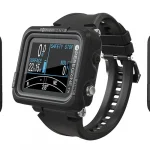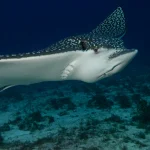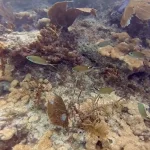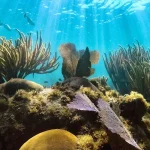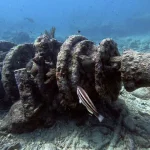Table of Contents
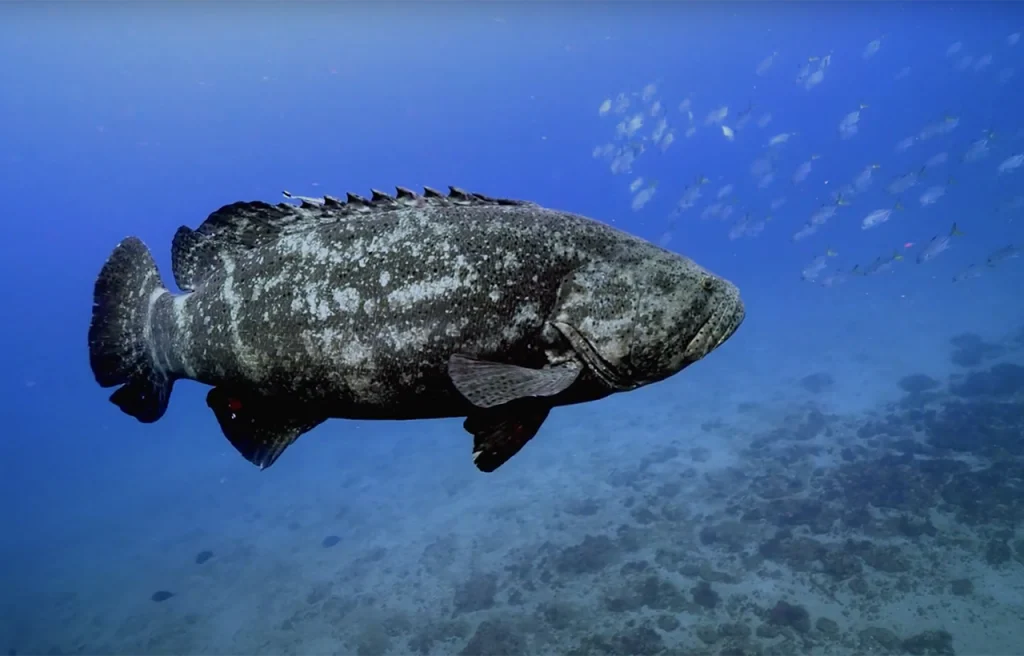
Area 51 is often described as the “Baskin Robbins of the Sea” due to its incredible variety of marine life, making it a must-visit site for divers exploring Jupiter’s underwater world.
Article at a Glance
- Location: Area 51 is a popular dive site located in Jupiter, Florida, known for its vibrant marine life and unique underwater topography.
- Depth: The dive site features depths ranging from 65 to 90 feet (20 to 27 meters), making it suitable for advanced divers.
- Visibility: Divers can typically expect visibility between 25 to 60 feet (7.5 to 18 meters), with the best conditions often occurring from January to April.
- Marine Life: Area 51 is home to diverse species, including reef sharks, Loggerhead turtles, Hawksbill turtles, Goliath groupers, and large schools of fish.
- Dive Conditions: The site features high ledges and crevices, along with potential currents, which can present challenges for divers.
- Best Time to Dive: The optimal time for diving is from January through April for shark sightings and August through September for goliath grouper spawning.
- Photography Opportunities: The site offers excellent photography prospects, particularly with wide-angle lenses and careful strobe positioning to capture the stunning underwater scenery.
Area 51 Jupiter
Area 51 is a popular dive site located in Jupiter, Florida, known for its diverse marine life and unique underwater topography. This high-ledge dive site offers an exceptional experience for scuba enthusiasts.
Dive Site Characteristics
- Depth: The top of the ledge is around 60-75 feet deep, with the sand bottom at 90 feet.
- Topography: Area 51 features a high ledge with numerous crevices for exploration.
- Visibility: The water is known for its unique “Jupiter Blue” color and is generally crystal clear.
Tips for Divers
- Be attentive at the beginning of the dive to spot curious reef sharks.
- Take your time and explore slowly to maximize marine life encounters.
- Look for turtles both under and on top of the ledge.
- Scan east and west of the ledge for larger aquatic life.
What Marine Life Can I Expect To See?
Sharks
- Reef sharks frequently greet divers soon after descending, typically approaching from the east
- Other shark species include lemon, tiger, and Caribbean reef sharks
Turtles
- Loggerhead turtles napping under the ledge at nearly 90 feet
- Hawksbill turtles feeding between cracks and crevices
- Green sea turtles also commonly encountered
Fish Species
- Large schools of Atlantic spadefish
- Barracuda (groups of 6-7 large individuals)
- Bar jacks
- Amberjacks
- Horse-eye jacks
- Goliath groupers
- Green moray eels
Additional Marine Life
- Southern stingrays in the sand
- Occasional scorpionfish
- Baitfish schools
- Potential encounters with dolphins, sailfish, and marlins
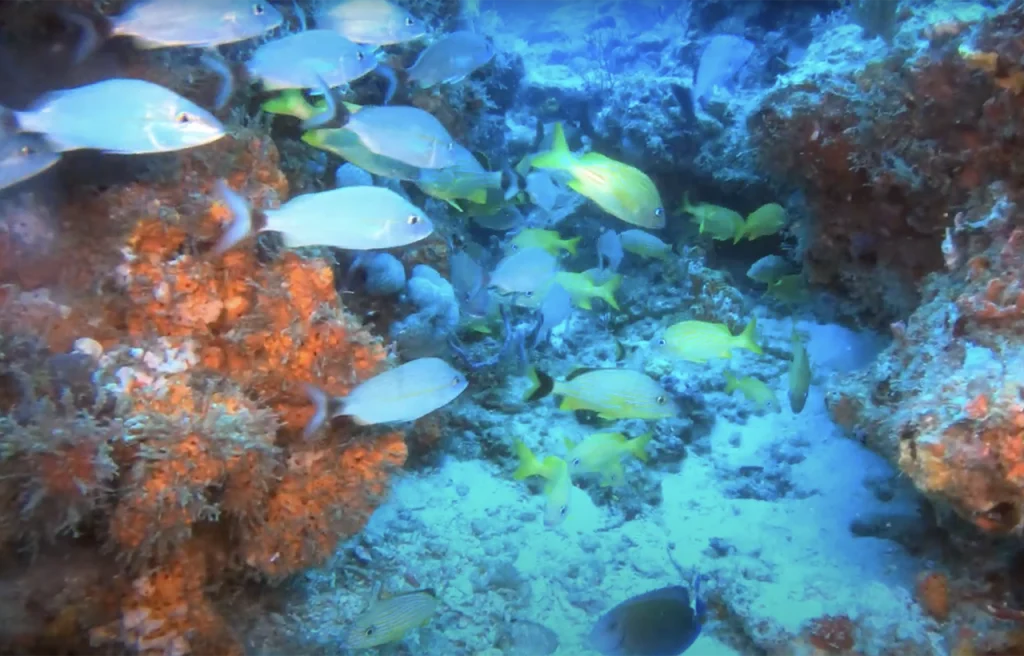
What Do Divers Say About This Site?
General Impressions
- Diverse Marine Life: Many divers highlight the incredible variety of marine life, including reef sharks, turtles, and large schools of fish. One diver noted that “if you must choose between all of the incredible diving in Jupiter… ask for Area 51” because it offers a sampling of underwater life akin to “Baskin Robbins of the Sea”.
- Unique Topography: The underwater landscape, characterized by high ledges and numerous crevices, is often described as mesmerizing. Divers appreciate the exploration opportunities these features provide.
Specific Experiences
- Shark Encounters: Divers often report being greeted by curious reef sharks shortly after descending, which adds excitement to the dive 2. One diver mentioned seeing multiple Goliath groupers during their dive, enhancing the experience further.
- Turtle Sightings: Loggerhead and Hawksbill turtles are commonly seen napping or feeding, making for memorable encounters.
Safety and Service
- Professional Crew: Reviewers consistently praise the professionalism and friendliness of the dive crew. Many divers feel safe and well-cared for during their dives, which contributes significantly to their overall enjoyment.
- Quality Equipment: Divers appreciate the well-maintained equipment and boats provided by dive centers like Jupiter Dive Center, which enhances their diving experience.
Key Information
| Category | Details |
|---|---|
| Location | Area 51, Jupiter, Florida |
| Depth Range | 65-90 feet (20-27 meters) |
| Visibility | Typically 25-60 feet (7.5-18 meters), varies seasonally |
| Best Time to Dive | January to April (shark season), August to September (goliath grouper spawning) |
| Suitability | Advanced divers recommended; not suitable for beginners |
| Marine Life | Reef sharks, Loggerhead turtles, Hawksbill turtles, Goliath groupers, Atlantic spadefish, barracuda |
| Dive Conditions | High ledges, crevices, potential currents |
| Photography Tips | Use wide-angle lenses, position strobes high and wide |
| Unique Features | Known for its diverse marine ecosystem and underwater topography |
Highlights of Diving This Site?
Marine Life Encounters
- Sharks: Divers are frequently greeted by 2-3 reef sharks soon after descending, typically approaching from the east
- Turtles: Multiple turtle species including:
- Gigantic Loggerhead turtles napping under the ledge at 90 feet
- Hawksbill turtles feeding between crevices
- Green sea turtles
Underwater Landscape
- High-ledge dive site with numerous crevices
- Depth ranges from 60-90 feet
- Incredible underwater topography with multiple exploration opportunities
Diverse Marine Species
- Large schools of Atlantic spadefish
- Small groups of barracuda (6-7 large individuals)
- Bar jacks
- Amberjacks
- Horse-eye jacks
- Green moray eels
- Southern stingrays
- Occasional Goliath groupers
Unique Characteristics
- Known as the “Baskin Robbins of the Sea” due to incredible marine diversity
- Crystal clear “Jupiter Blue” water
- Unpredictable marine life encounters make each dive a mystery adventure
My Favorite Dive Computers
I have compared the 3 top diving computers for each category to help making the right choice easier:
Iconic Spots At This Site
Area 51
- Description: Known for its high ledge and rich marine life, divers often encounter curious reef sharks shortly after descending.
- Marine Life: Expect to see Loggerhead turtles, Hawksbill turtles, green moray eels, and a variety of tropical fish.
Tunnels
- Description: This site is renowned for its underwater tunnels and large aquatic life encounters.
- Highlights: Divers can expect to see Goliath groupers, reef sharks, and southern stingrays as they navigate through the tunnels.
Scarface (Spadefish Point)
- Description: Named after a legendary scarred green moray eel, this site features stunning topography.
- Marine Life: Divers often spot Green, Loggerhead, and Hawksbill sea turtles, along with Goliath groupers and various reef fish.
Captain Mike’s
- Description: A high ledge averaging between 15 to 20 feet from the sand, offering a vibrant ecosystem.
- Highlights: This site is known for encounters with spotted eagle rays and the resident Goliath grouper named “Tug.”
MG-111 (Lighthouse)
- Description: Lined up with the Jupiter Lighthouse, this site is slightly shallower than others.
- Marine Life: Offers a wide variety of species including reef sharks, eels, goliath groupers, and lobsters.
Environmental Conservation Efforts at Area 51
Sawfish Bay Marine Restoration Project
This multi-year initiative aims to:
- Install a living shoreline
- Restore marine habitat
- Install artificial reef modules
- Promote seagrass and oyster growth
- Contribute to the recovery of threatened and endangered species
- Improve water quality
- Enhance resiliency of approximately 7,000 linear feet of shoreline (1)
Jupiter Inlet District Conservation Efforts
The Jupiter Inlet District, established in 1921, works to:
- Maintain the inlet and navigable channel
- Preserve and protect important waterways and natural resources
- Safeguard wildlife in the Jupiter Inlet and Loxahatchee River-Lake Worth Creek Aquatic Preserve (2)
General Conservation Practices
While not specific to Area 51, divers in Jupiter are encouraged to:
- Be attentive and respectful of marine life
- Avoid touching or disturbing underwater habitats
- Practice responsible diving techniques to minimize impact on the environment
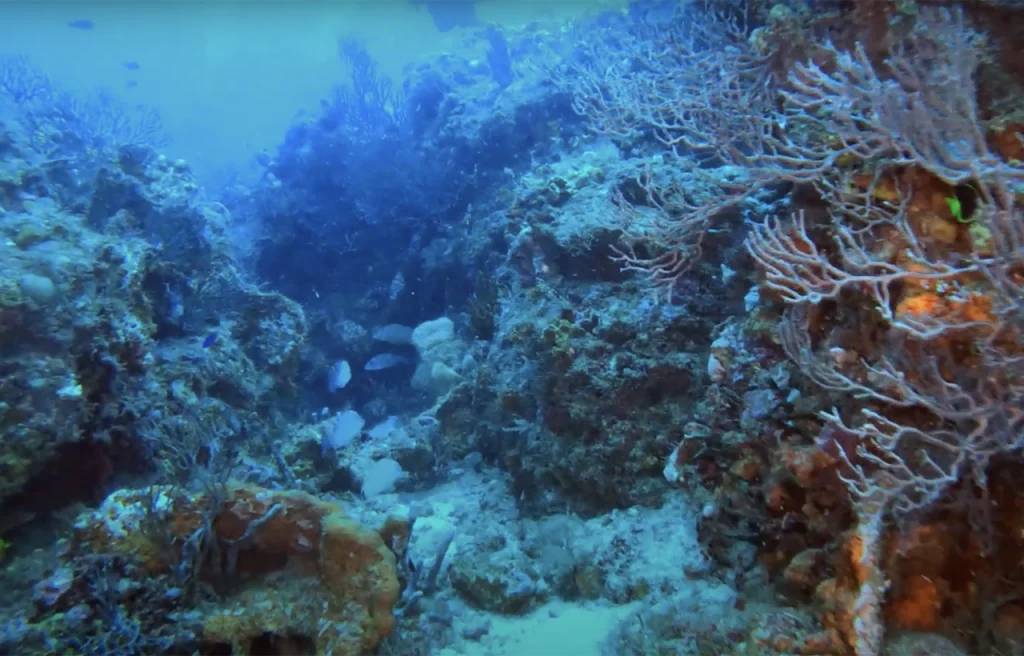
Maximizing Your Diving Experience at Area 51
Timing and Preparation
- Plan your dive during the best visibility conditions, typically when the water is crystal clear “Jupiter Blue”.
- Bring a flashlight to explore crevices and enhance your viewing experience.
- Consider using nitrox to extend your bottom time, as the site is relatively deep.
Dive Techniques
- Upon entering the water, be alert for reef sharks, which often appear quickly but may disappear just as fast.
- Descend carefully and watch for 2-3 reef sharks that frequently greet divers, typically approaching from the east.
- Move slowly and deliberately to avoid missing any subjects, especially when searching for unique marine life.
Marine Life Encounters
- Look for gigantic Loggerhead turtles napping under the ledge at depths near 90 feet.
- Search for Hawksbill turtles feeding between cracks and crevices.
- Keep an eye out for large schools of Atlantic spadefish and small groups of barracuda.
- Scan for green moray eels, including the legendary “Scarface” if you’re lucky.
Exploration
- Take time to explore the high ledge and numerous crevices that characterize the site.
- Visit the three tunnels, with special attention to the first one where goliath groupers often congregate.
- Alternate between examining the reef structure and scanning the open water for larger pelagic species.
Photography
- Position your strobes wide and high to avoid blowing out the sandy bottom in your shots.
- Be patient and allow sharks to approach you for the best close-up opportunities.
- Capture the unique “Jupiter Blue” water color in your wide-angle shots.
Capturing Memories at Area 51 in Jupiter: Photography Tips
Equipment Recommendations
- Camera Setup: Use a wide-angle lens, such as a fisheye or rectilinear lens, to capture the expansive underwater scenery and large marine life. A fisheye zoom lens is particularly effective for close encounters with curious sharks.
- Strobes: Position your strobes high and wide when shooting over sandy bottoms to avoid blowing out the sand. Consider using one strobe to illuminate the underside of the subject and another for the top, adjusting their power for optimal lighting (4).
Shooting Techniques
- Streamline Your Gear: Ensure your dive gear is comfortable and streamlined to allow for quick movements and responsiveness during fast-action moments.
- Stay Calm: Sharks are naturally curious and may approach you if you remain calm and still. Avoid sudden movements that could scare them away; let them come to you for the best close-up shots.
- Use Natural Light: When possible, take advantage of natural light during shallower dives. This can enhance the color saturation in your images (3).
Composition Tips
- Framing: Pay attention to your framing, especially with larger subjects like sharks or turtles. Use the environment creatively to add context and depth to your photos.
- Background: Keep the background bright and blue by adjusting your strobes accordingly. This contrast can make your subjects pop in the final images.
Dive Planning
- Timing: Plan your dives during times when visibility is optimal. Early morning or late afternoon dives can provide unique lighting conditions.
- Explore Slowly: Take your time to explore the site, as rushing can lead to missed opportunities for capturing unique marine life interactions.
Post-Dive Considerations
- Review Your Shots: After each dive, review your images to understand what worked well and what could be improved for future dives.
- Practice Makes Perfect: The more you dive and practice underwater photography, the better your skills will become. Consider multiple trips to capture different aspects of this vibrant ecosystem.
Frequently Asked Questions
When is the best time to dive Area 51 in Jupiter?
The best time to dive at Area 51 in Jupiter, Florida, is generally considered to be from January through April. During this period, divers can expect optimal conditions and a variety of marine life encounters:
Shark Season (January – March): This is a prime time for seeing lemon sharks and migrating blacktip reef sharks, making it an exciting period for shark enthusiasts.
Sea Turtle Season (March – September): The likelihood of encountering sea turtles increases significantly during this time, as Jupiter has one of the densest sea turtle nesting populations in the nation.
Goliath Grouper Season (August – September): For those interested in larger species, goliath groupers aggregate to spawn during late summer, offering spectacular sightings.
What is the visibility like while diving Area 51 in Jupiter?
The visibility at Area 51 in Jupiter, Florida is exceptional, typically ranging from 25 meters (about 60 feet) to 10-25 meters depending on the season. The site is known for its crystal-clear “Jupiter Blue” water, though the sandy bottom and occasional currents can sometimes reduce clarity.
Visibility Characteristics
Average Visibility: 25 meters (60 feet)
Seasonal Variations:
– February: Consistent 25-meter visibility
– June: 10-25 meters visibility
– August: Can drop to 5-25 meters
– September: Returns to 10-25 meters
Additional Notes
– The water is described as having a unique “Jupiter Blue” color
– Sandy bottom and currents can occasionally kick up sediment
– Divers can expect crystal-clear conditions in optimal months
One dive report enthusiastically noted that the visibility is “amazing” and the water is “largely speaking, crystal clear”, making Area 51 an outstanding dive site for underwater exploration2.
How deep are the dives at Area 51 in Jupiter?
At Area 51 in Jupiter, Florida, divers can expect the following depth profile:
Top of the Ledge: Approximately 65-75 feet (20-23 meters)
Bottom of the Reef: Around 90 feet (27 meters)
Vertical Face: Considered the most extensive in the area, with a significant drop from the top of the ledge to the sandy bottom
Divers typically descend nearly 60 feet to reach the top of Area 51, then descend another 30 feet to explore the bottom of the reef. This depth range makes Area 51 a site best suited for experienced divers who are comfortable with deeper dive conditions.
Is Area 51 in Jupiter suitable for beginners?
Area 51 in Jupiter, Florida, is generally not considered suitable for beginner divers due to several factors:
Depth and Experience Level
Depth: The dive site features depths ranging from approximately 65 to 90 feet, which can be challenging for novice divers who may not be comfortable at these depths or managing their buoyancy effectively.
High-Ledge Characteristics: The underwater topography includes high ledges and crevices, which require a certain level of comfort and skill to navigate safely.
Marine Life Interactions
Shark Activity: Divers are often greeted by curious reef sharks shortly after descending. While this can be an exhilarating experience, it may be intimidating for beginners who are not accustomed to diving with larger marine life.
Varied Conditions: The site can experience currents that may complicate diving for those without sufficient experience in managing such conditions.
Is Area 51 in Jupiter suitable for advanced divers?
Area 51 in Jupiter is an excellent dive site for advanced divers due to its unique characteristics:
Dive Site Features
Depth Range: 65-90 feet, which requires advanced diving skills
Complex Topography: High ledges, multiple crevices, and intricate reef structures
Marine Life Diversity: Offers encounters with multiple advanced-level marine species
Advanced Diving Challenges
– Requires comfort with deeper dive profiles
– Navigating high ledges and underwater tunnels
– Managing potential currents
Handling close encounters with marine life like:
– Reef sharks
– Goliath groupers
– Multiple turtle species
– Barracuda schools
Recommended Experience Level
Best suited for divers with:
– Advanced Open Water certification
– Significant deep diving experience
– Comfort in depths exceeding 60 feet
– Strong buoyancy control skills
Jupiter Dive Sites
- Area 51
- Area 29
- Tunnels
- Loggerhead Reef
- Bluffs Reef
- Bonnies
- Captain Kurls
- Spadefish Point
- Coral Cove Park
- Captain Mike’s
- Julies
- Emerald Charters Shark Dive
- Jupiter Wreck Trek
- Donut
- Scarface Reef Andrew “Red” Harris No Shoes Reef
- Jupiter Inlet
- Step Reef
- Sawfish Bay
- Marine Restoration Reef
- North County Reef
- Lighthouse
- Finz Den
- High Ledge
- Leigh’s Ledge
- Monkey’s Ledge
- Gary’s

